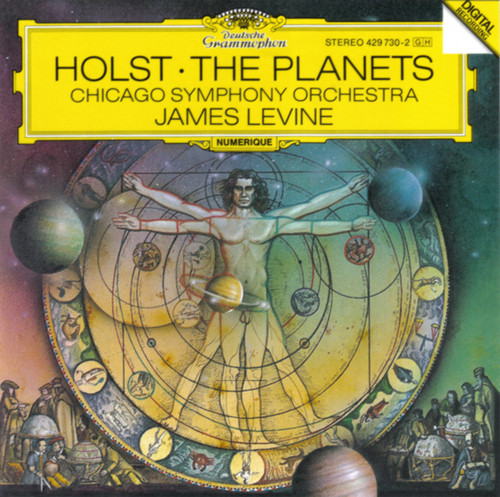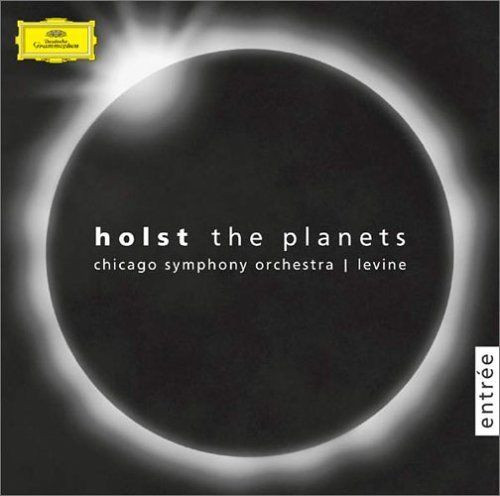This is a superficial reading (not a lot of profundity here, folks), but boy is it enjoyable. It’s tremendously exciting. This is the version to play if you to want to be impressed. But you won’t want to try to impress any of your hi-fi friends with it, because the mastering on this recording is horrible. All the transients (i.e., the quick loud bits) have been curtailed so there’s a loudness ceiling and nothing goes above it. (See the Wikipedia article on the Loudness war for a better explanation.) Good performance. Bad mastering. Very bad mastering.
As for individual movements, there’s not a lot to report. In “Mars”, a trumpet plays a bad note at 1:36 and the same trumpet gets a bit lost from 1:39-1:41, but that’s about it for anything I’d call (wait for it…) noteworthy.
“Saturn” is pretty good, apart from some sloppy playing in a few places (4:58, 5:20), and someone plays a sour note in “Uranus” (1:01).
But honestly, I’m nitpicking for no decent reason.
This is fun, fun, fun.

Regarding your complaint about the dynamic limitations of this recording, may I ask if you were auditioning the CD, or an MP3?
LikeLike
CD.
I’ll give you graphic demonstration of why the Levine recording is a shocker in the audio department.
Here’s how Dutoit’s “Mars” looks in an audio editing program:
If you’re not familiar with what audio looks like, the blue part of the image is the music. The narrow parts of blue is when the music is quiet. So the taller the blue area, the louder the music.
You can see with Dutoit’s recording that are no restrictions on the dynamic range. The music is free to be as loud as it wants.
Now, with the Levine recording you can immediately see the difference:
The volume’s been cranked right up for the whole thing. As a result, the loud stuff is restricted – it isn’t allowed to go above the maximum volume in CDs.
This “hitting the volume ceiling and staying there” scenario is very common in pop music, but very rare in classical music. (Note to the Producers: The Planets is not pop music, guys.)
The Levine Planets is actually the first (and only) recording of the work I’ve come across where the dynamic range has been restricted. That, for me, is a big no-no.
LikeLike
Many thanks for your explanation.
LikeLike
For whatever reason, my Levine Mars more closely resembles Dutoit’s in my audio editing software, though your point is still well taken. The biggest issue I have is the extreme variance in volume between the very soft passages and the loudest. like more than 25 db! But since I do audio editing, I boost the audio in those sections by roughly 6 db. Certain sections throughout the program require mid range and bass boosting as well (ala Dutoit). If you do some of these things you can vastly improve the dynamics and overall quality of the program.
LikeLike
Howdy, Tad.
The audio editing software I used was Sony Sound Forge, and the audio files were FLACs ripped from the CDs. I wondered why the Levine would look different in the software you used, so I opened Levine’s “Mars” in two other audio programs, AVS Audio Editor and Audacity.
Here’s how Levine’s “Mars” looks in AVS Audio Editor:
The Planets – “Mars” (Levine)

And here it is in Audacity:
The Planets – “Mars” (Levine)

I don’t know what program you used, but in both those screenshots I see a restricted dynamic range (the loud parts have all been flattened). I may have mentioned this before, but to restrict the loudest parts of classical music prompts me to say, “Please don’t do that”. It’s the kind of thing that makes me go “Grrr”.
Grrr.
Admittedly, the Levine recording does sound terribly exciting, but the audio engineering messes about with the natural dynamic range of the music, and that, for me, is close to unforgivable in recording classical music.
So marks off for Levine’s recording. (I’ll look at Levine’s recording sternly and say, “You’ll stay at number 14 on the list until you’ve thought about what you’ve done.”)
LikeLike
Hi there Peter!
Thanks for a lovely and informative blog about The Planets! Quite the resource.
I own a handful of copies of this masterpiece and this Levine one is my favourite. I am an audio engineer by profession and agree that one should never use a limiter or a compressor when mastering classical music. Those waveforms you show are typically the result of heavy-handed limiting. Possibly some compression too to reduce the dynamic range.
When I listen to this recording, however, I cannot hear the brutal limiting those waveforms illustrate. Like other listeners here and reviewers I find the dynamic range huge, which is why I love the Levine recording so much, and makes me curious to compare those waveforms with my copy.
I am unable right now to extract waveforms from my copy, but out of curiousity I checked Discogs to see if this recording has different versions on the market.
According to Discogs, this particular recording was released originally in 1990, but then it was reissued in 2004 when it was remastered by Emil Berliner Mastering. Could it possibly be that there is one version out there that has been subjected to an all too heavy-handed remastering, and another one, untouched, retaining the full dynamic range?
Can you check exactly which CD edition you own? Barcode. Check the credits text etc.
LikeLike
Hi, Daniel
Thanks for the thanks.
I have the original 1990 US release:
https://www.discogs.com/release/3163420-Holst-James-Levine-2-Chicago-Symphony-Orchestra-The-Planets
In the last page of the booklet, it says this:
———————————————————
Recording: Chicago, Orchestra Hall, 6/1989
Executive Producer: Dr. Steven Paul
Recording Producer: Christopher Alder
Balance Engineer: Gregor Zielinsky
Recorded using B&W Loudspeakers
Publishers: J. Curwen & Sons / Faber Music, London
(P) 1990 Deutsche Grammophon GmbH, Hamburg
(C) 1990 Dr. Stephen Banfield, Prof. Dr. Gian Paolo Minardi
Cover Illustration: Bernd Rüttiger, Nuremberg
Photo of Holst: Archiv für Kunst und Geschichte, Berlin
Art Direction: Peter Schuppe
———————————————————
Here are scans from my CD:
I haven’t heard the 2004 release. (I’m now in the mood to buy it so I can compare the two releases for mastering.)
LikeLike
Howdy (again), Daniel
I bought the 2004 reissue of the Levine Planets today. When it arrives in the household, I’ll compare the waveforms of that to the original 1990 release.
Incidentally, I must admit that when I’m listening to the recording – that is, the 1990 CD with the limiting – I don’t hear any limiting. I guess that’s an example of good mastering.
1990 release:

2004 release:

LikeLike
My 2004 Levine Planets CD arrived in the mail today.
Here are the FLAC rips of the 1990 and 2004 releases:
LikeLike
Had another quick look at Discogs.
The original edition from 1990 has barcorde: 028942973022
This edition has no credits whatsoever regarding mastering. One person is credited as the balance engineer (which should mean mixing), and another as the recording producer.
The remastered edition has barcode: 002894775010
Credits say:
Mastered by Emil Berliner Studios.
(P) 1990 (Holst) / 1986 Deutsche Grammophon GmbH, Hamburg
(C) 2004 Deutsche Grammophon GmbH, Hamburg
/Daniel
LikeLike
another one i need to hear completely, heard good things about :)
LikeLike
What a pity that the mastering got messed up. I suspect this album would have ranked a bit higher in your list otherwise. I’m really fond of Levine & his CSO’s performance.
LikeLike
It looks as if the peaks actually go over rather than hit a limiter. That looks like HDCD encoding. It was a fad about 30 years ago – an HDCD player would magically “unlock” an extra 6dBs of dynamic range. I’ve forgotten the mechanics of it, but it was an abject failure.
I’m not sure why an HDCD wouldn’t rip with full dynamics.
LikeLike
Here are the waveforms for Levine’s “Mars” in the audio program ocenaudio:
1990 CD

2004 CD

LikeLike